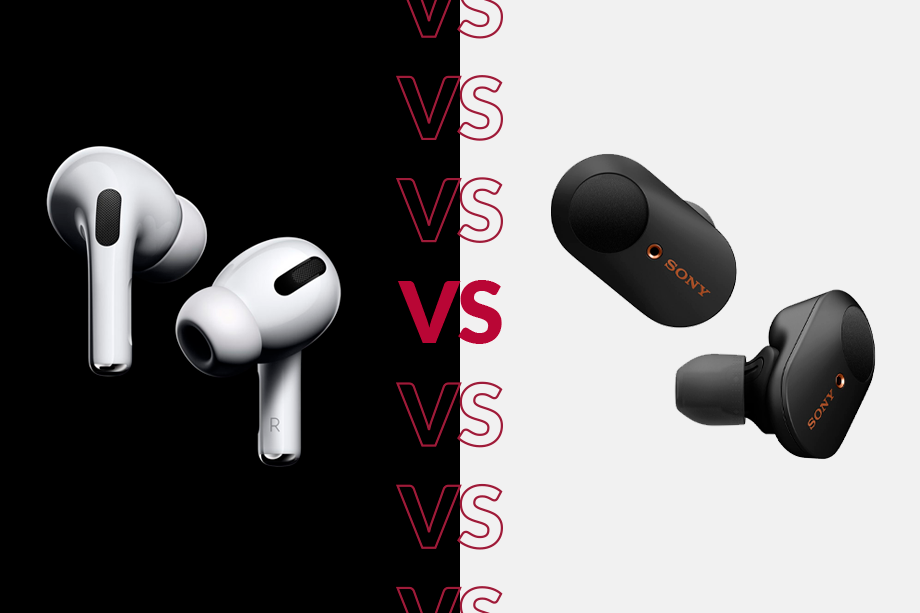AirPods Pro vs Sony WF-1000XM3: Which ANC wireless earbuds are best?

The AirPods Pro and Sony WF-1000XM3 are two of the more popular pairs of true wireless earbuds on the market, but which one should get your cash?
The AirPods Pro are the premium AirPod earbuds, offering better design and sound than the standard AirPods (2019), as well as introducing active noise cancellation to the range. The Somy WF-1000XM3 are the follow ups to Sony’s WF-1000X with improved features, design and wireless connectivity.
Both have an RRP over £200, cementing their status as premium wireless earbuds over £200/$200 RRP, but which pair are the best option for you?
Related: Best wireless earbuds
Apple AirPods Pro vs Sony WF-1000XM3 – Price
A pair of AirPods Pro will set you back £249 with a wireless charging case, and Apple products don’t often come down in price. That’s £50 more than the standard AirPods and £90 more than the entry-level version.
The Sony WF-1000XM3 have an RRP of £220, but you can find them for a lot less at their current price of £169. The Sony does not come with wireless charging (if that’s of any interest), but their focus on premium sound the AirPods Pro pricey in comparison.
Apple AirPods Pro vs Sony WF-1000XM3 – Design
These two earbuds would struggle to be more different. The AirPods Pro are white, with a glossy finish and stick out with AirPods stem. The WF-1000XM3 are subtler with their compact and circular construction that’s available in black and silver variants. Both earbuds offer a range of silicone ear tips in sizes small to large for a custom fit.
The WF-1000XM3 have touch panels for playback (pause/play/skip). battery life. The AirPods’ controls are located at the bottom of the capacitive stem. The Sony controls work fairly well, proving responsive to touches. They can also be customised for left-handed users in the Headphones app. On the other hand, the AirPods Pro control system we found fiddly and not the most responsive.
One big upgrade from the AirPods to the AirPods Pro was the introduction of an IP rating. The AirPods Pro received an IPX4 rating, meaning the headphones can hold their own against rain and sweat. Sony hasn’t specified an IP rating its earbuds, so while we assume they can withstand some rain, we wouldn’t say these would be suitable for the gym.
Despite that the Sony’s would get our vote here thanks to the better implemented controls.
Related: Best noise cancelling headphones
Apple AirPods Pro vs Sony WF-1000XM3 – Features
Both the AirPods Pro and the Sony WF-1000XM3 feature Active Noise Cancellation (ANC). The WF-1000XM3 noise cancellation is powered by Sony’s HD Noise Cancelling Processor QN1e chip. The addition of an Adaptive Sound Control feature allows the headphones to measure noise levels and adjust the noise cancellation on the fly.
The ANC on the AirPods Pro is less customisable but still effective. There’s a Transparency mode to let noise in when needed, such as train announcements and coffee orders or you can disable it entirely.
As far as battery life is concerned, AirPods Pro offers four and a half hours per charge, with a 24 hour battery life in the wireless charging case. The WF-1000XM3 is more impressive with six hours for a total of 24 with ANC on. Turn ANC off and that extends to 32 hours. The case cannot be charged wirelessly if that’s an issue.
The WF-1000XM3 Bluetooth connection is much more stable than its predecessor. According to Sony, this is due to the redesigned antenna structure and move to left/right simultaneous transmission. The AirPods also boast a strong connection, especially in conjunction with other Apple devices. That said, these headphones play well with any Bluetooth-supporting device, so don’t worry if you don’t have an iPhone 11.
Apple AirPods Pro vs Sony WF-1000XM3 – Sound
Sound quality wasn’t the original AirPods strong suit. The poor seal generated by the fit was prone to letting noise in to distract from the audio. The AirPods Pro are an improvement in this respect, with eartips and in-ear design. As a result, they offer deeper bass and more detailed vocals across a wide range of musical genres. The headphones also offer a warmth absent from the original AirPods.
The Sony WF-1000XM3 are also have an impressive performance that works well across a range of musical styles, with a sound signature comparable to Sony’s WH-1000XM3 over-ears. The WF-1000XM3’s versatility ensures it’s capable of handling tracks that are delicate in nature, as well as tunes with more dynamism to them. The soundstage is wide and vocals rendered with clarity, while the bass performance is smooth and textured without overpowering the presentation.
The Sony’s more neutral sound is a step-up over the AirPods Pro’s warmer presentation. With better bass, a cleaner and more detailed midrange, the Sonys are for music lovers, but don’t discount the AirPods Pro either, which have a genuinely entertaining sound.
Apple AirPods Pro vs Sony WF-1000XM3 – Verdict
Both sets of headphones boast ANC and ‘sticky’ connections, though the AirPods may be a better suit for iPhone users. If you’re an Android user, the Sonys are the better option.
Though you can get the same battery life out of both headphones with ANC on; the Sonys can be extended further if ANC is switched off. The AirPods’ IP rating makes them more suitable for use in the gym, and like the Sony they are very comfortable to wear, if not more so.
As far as sound quality is concerned, the WF-1000XM3 come out on top, but Apple users won’t be disappointing about the quality of the AirPods Pro. If your biggest priority is sound, the Sony WF-1000XM3 are your best pick. The audio quality, along with ANC and Adaptive Sound Control, is a formidable performer in the true wireless realm.


